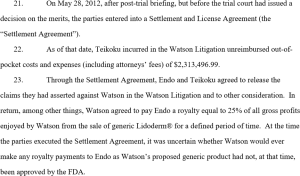Disclosure: the majority of the companies mentioned below are, or have been, clients of DrugPatentWatch
Drug patent litigation can be used for many aspect of biopharmaceutical business strategy.
Many parties have an interest in being able to anticipate generic drug market entry, and tracking litigation can provide information on the potential for earlier-than-expected generic entry (i.e. through invalidation of patents), can be used to help generic challengers learn from prior failed patent challenges and draft strategies to overcome patents, and finally, public information in litigation proceedings can be used to gain competitive intelligence.
A popular reason to examine patent litigation is to study the strategies of patent challengers and defendants, and then use this knowledge to either write stronger patents or to find ways to successfully challenge patents. This article won’t be discussing patent challenges, but instead will focus on using public disclosures in the course of litigation to gain business intelligence.
Learning About Settlement Terms
The example case we will be discussing in this article is Teikoku Pharma USA, Inc. v. Endo Pharmaceuticals, Inc. This case is selected because it addresses a contract dispute, which is ripe territory for finding business intelligence. One of the distinguishing characteristics of DrugPatentWatch is that our patent litigation database includes all district court cases mentioning a patent — not just the patent infringement lawsuits. This means that the patent litigation database includes contract disputes, reclamation of unpaid taxes, antitrust proceedings, and more.

Figure 1 shows the basic nature of the lawsuit between Teikoku and Endo. Briefly, Teikoku asserted that they had an agreement with Endo in which Endo would reimburse Teikoku for expenses incurred in pursuing patent infringement claims against third parties and that Endo failed to satisfy the terms of that agreement. We won’t go into the details of the lawsuit — the purpose of this article isn’t to assign blame — but rather we will examine the court proceedings for valuable business intelligence.
The first disclosure in the case, the nature of the suit, already reveals valuable information — if Teikoku’s statement is accurate, it indicates that future partners with Endo may want to consider asking for Endo to cover litigation expenses. For it appears that Endo is willing to accommodate these terms in their partnership agreements. It is also worth noting that partners with Endo who have expense-recovery clauses in their agreements should review the full proceedings of the litigation to ascertain the likelihood of receiving compensation for pursuing patent infringers.
How Much Will a Company Spend to Pursue Patent Infringers and What Tactics Will They Employ?
The risk of being sued for patent infringement is a persistent concern among generic companies. Even in cases where generic firms act in good faith that they are not infringing any patents there remains the risk that a patent holder will view the situation differently and pursue legal action. So, an important consideration in launching generic drugs is to evaluate the strength of cases which may be brought by patent owners, and the resources which the patent owners may dedicate to challenging infringers.

Figure 2 provides key insights into Teikoku’s tactics in pursuing perceived patent infringers — they spent $2.3 million in litigation against Watson. Further they entered into a settlement agreement to resolve the dispute. A deeper look into Teikoku’s litigation with Watson could yield additional insights into the other tactics employed by Teikoku.
Companies finding themselves defending against infringement suits from Teikoku can expect Teikoku to spend at least $2.3 million on their prosecution of the case, and they can further anticipate that a settlement of 25% of gross profits may resolve the matter. Further, companies asserting patents against Watson can expect that Watson may agree to pay a 25% royalty. Interestingly, as stated by Teikoku, the receipt of royalty earnings was uncertain given that Watson had not yet received approval for the generic product.
It may be worth examining why Teikoku would agree to a royalty settlement, and one with the potential for no income, instead of completing the litigation and potentially wholly excluding Watson from the market for the duration of the contested patent.
Analysis of additional cases can set general expectations of patent litigation tactics and acceptable settlement terms.
How Much did a Licensee pay in Royalties?
After learning of Teikoku’s partnership terms with Endo, and of Teikoku’s tactics in pursuing perceived infringers, it is still possible to learn more from this case.

Teikoku’s assertions in Figure 3 claim that Endo earned over $100mm in license fees from Watson over the roughly 21 month timespan cited. Back-calculating from the 25% royalty rate, it would appear that Watson’s sales were over $200mm/year.
Beyond learning about Endo’s royalty earnings or Watson’s revenues from generic drug sales, tactical information can also gleaned from this case. It would appear that Watson’s minimum threshold for generic drug sales is at least $200mm/year and a 25% royalty to avoid litigation may be preferable to protracted litigation with the opportunity for patent invalidation.
Extracting Valuable Business Intelligence from Public Disclosures in Court Records
As this case has shown, even in the absence of following it to the resolution of the contractual dispute between Teikoku and Endo, it is possible to learn about revenues from a third party — Watson Pharmaceuticals, of the potential development agreement terms one may anticipate from Endo, and of the patent litigation tactics of Teikoku.
There are many ways to obtain business intelligence. While rumor mills and opinions from industry analysts can provide unconfirmed rough benchmarks, information elucidated from litigation as illustrated here can be used to confirm or expand estimates. DrugPatentWatch offers the tools to continuously track patents covering drugs, litigations, tentative generic approvals, and other factors essential to making better decisions. For more information, request a demo and learn more about our subscription options.























